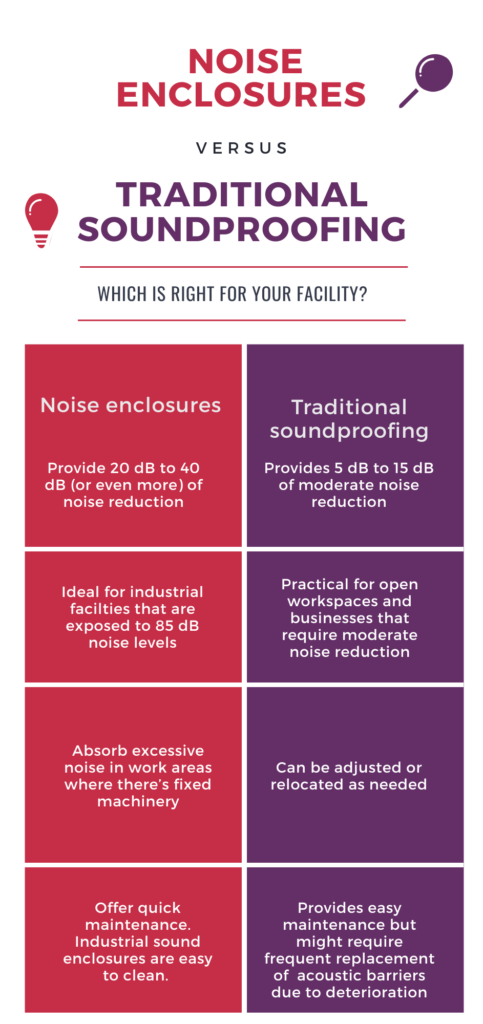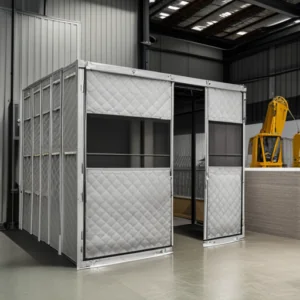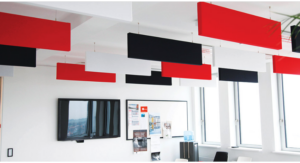American Made, Iron Clad Protected - Discover the Industries Best Warranty.
Blog
Noise Enclosures vs. Traditional Soundproofing: Which Is Right for Your Facility?
Noise Enclosures vs Traditional Sound Proofing
Over the years, excessive noise has become a common challenge in industrial environments. 25% of industrial workers in the U.S. have developed hearing impairment, according to NIOSH. Continuous noise also plays a devastating role in hindering workers’ productivity while causing workplace burnout. This is one of the reasons why facility managers emphasize deploying the right soundproofing methods within noisy work zones.
When it’s about decreasing the impact of noise, business managers often face this confusion: to choose “noise enclosures” or go with the “traditional soundproofing” method. Both options have their distinct advantages. The final choice depends on the unique needs of your facility. That’s why it’s important to compare both options before investing in one of these sound-dampening methods.
In this post, we’ll dive deeper by comparing industrial sound enclosures and traditional soundproofing techniques in terms of their functionality, cost, effectiveness, and installation complexity.
What Are Noise Enclosures Best for?
Also called industrial sound enclosures, also called noise enclosures are an ideal soundproofing option for industries that must manage excessive noise to meet OSHA regulations. OSHA has set specific hearing conservation standards for industrial environments where noise levels are at 85 dB or exceed this limit (within eight working hours). In this scenario, facility manager should be able to achieve regulatory compliance to ensure worker’s optimal hearing health while avoiding heavy fines.
Some examples of industries in which workers are exposed to dangerously high noise include oil and gas extraction, manufacturing, construction, mining, aerospace, and transportation. If installed in these industrial facilities, noise enclosures can absorb loud noise from heavy machinery, compressors, generators, HVAC systems, and other noisy equipment.
Noise enclosures have the modular “room-within-a-room” structure that helps isolate unwanted noise at specific work zones. Since these enclosures are customizable, you can build them nearby or around existing equipment that produces extreme noise.
What Is Traditional Soundproofing Best for?
Some businesses do not generate dangerously high levels of noise in their respective workspaces. Therefore, they might not need heavy-duty noise-absorbing enclosures. However, they still face acoustic issues such as echo, ambient distraction, and speech intelligibility that could affect workers’ mental health negatively. Examples of businesses belonging to such industries include open plan workspaces, healthcare facilities, educational institutions, retail stores, libraries, hotels, co-working spaces, and fitness studios. Traditional soundproofing is a great option for these businesses so they can achieve higher focus, comfort, and minimum noise-related distractions.
Traditional soundproofing includes various sound-absorbing methods. Some of these are acoustic panels (freestanding or wall-mounted), sound-dampening insulation (made of mass-loaded vinyl, foam, or fiberglass), fabric panels, sound-absorbing carpets, furniture, and bass traps.
Depending on the noise control requirements, these workspaces can achieve noise reduction by installing traditional soundproofing techniques. It’s also a feasible option for business owners who want to retrofit an existing space without implementing any major changes.
Key Differences between Noise Enclosures and Traditional Soundproofing
It often becomes challenging to pick a single option when both offer unique benefits. So, understanding the key differences between noise enclosures and traditional soundproofing will help you decide what works practically for your industrial facility.
Here’s the breakdown of the factors that differentiate one soundproofing solution from the other:
Noise reduction
Noise enclosures: provide 20 dB to 40 dB (or even more) of noise reduction in industrial workplaces where workers are exposed to high-intensity sounds of 85 dB or more while working near extremely loud hydraulic systems, compressors, and other machinery.
Traditional soundproofing: provides 5 dB to 15 dB of moderate noise reduction in open workspaces. Acoustic panels, insulation, and barriers absorb noise but don’t fully reduce it.
Cost
Noise enclosures: the initial cost is higher (due to specialized materials, structural supports, and custom fabrication) but it’s a worthwhile investment for long-term industrial productivity.
Traditional soundproofing: the upfront cost is lower since acoustic materials are easy to install. It can be a practical choice for budget-oriented businesses.
Mobility
Noise enclosures: these absorb excessive noise in work areas where there’s fixed machinery. But these enclosures can be moved easily since the structure is semi-permanent. It requires disassembling the enclosures first.
Traditional soundproofing: these can be relocated or adjusted as needed.
Installation
Noise enclosures: require professional installation or assembly. Building the booth is a one-time effort as its specialized noise-blocking materials can be sewn together. With the support of metal frames, enclosures are attached with Velcro and grommets.
Traditional soundproofing: these also require professional support but can be fitted to existing walls, floors, or ceilings (from-scratch installation isn’t necessary).
Maintenance
Noise enclosures: offer quick maintenance. Industrial sound enclosures are easy to clean. An industrial solvent and a cloth are all you need to wipe off debris or dirt from the enclosures.
Traditional soundproofing: provides easy maintenance but might require frequent replacement of acoustic barriers in case of deterioration due to harsh weather.
Signs You Should Prefer Noise Enclosures
Your machinery generates unbearable noise and you cannot move it frequently
If your facility contains heavy machinery that exceeds 85 dB, it can lead to negative consequences regarding workers’ hearing ability. Besides, OSHA may impose a heavy fine on your business for not following its industrial noise control regulations. A manufacturing facility, for instance, having an air compressor that produces noise of 120 dB must install a noise enclosure to achieve safer levels (i.e. below 85 db).
You prefer noise not to escape from a confined room
A noise enclosure acts as a small room in which noise being generated from loud equipment can be trapped inside. There’s no way for it to spread across an industrial facility. If you want to trap excessive sound inside without distracting employees working in the same facility, industrial sound enclosures will work well. These are especially crucial in data centers, pump stations, and power plants.
Scenarios in Which You Should Select Traditional Soundproofing
Your equipment can be moved easily
Freestanding acoustic panels, sound blankets, and acoustic wall systems are flexible sound-absorbing options for facilities that have moveable equipment. So, traditional soundproofing is a feasible option if you have an industrial setup where work processes are constantly changing and the loud machinery also requires relocation.
Noise sources are dispersed in an open facility
Noise enclosures go great if you need to isolate a specific equipment or machinery. But if you are managing a workplace that’s exposed to noise coming from diverse sources, it’s practical to go for general noise-blocking barriers.
The Takeaway
Now that you have a clear idea of the soundproofing solution that suits your business requirements the most, you can easily make the right choice between noise enclosures and traditional soundproofing. Choosing industrial sound enclosures is a wise idea if you have stationary equipment that’s extremely loud (requiring high levels of noise reduction measures). These enclosures are also great for external industrial activities to withstand extreme climatic conditions and block outdoor noise. However, traditional soundproofing can be an effective approach if the objective is to manage moderate noise at a lower budget.
Whichever option you want to select, the best bet is to go for a custom-built option to ensure optimal sound control. You can also select a hybrid sound reduction approach (install both noise enclosures and traditional soundproofing panels) if you have to deal with general noise and extreme noise sources simultaneously.
Recent Posts
- The Silent Safety Hero: Why Fixed Draft Curtains Are Required in High-Rack Storage Facilities
- The Invisible Risk: How Contamination Happens Without Proper Warehouse Barriers
- Are Your Insulated Warehouse Curtains Compliant
- Understanding Noise Regulations – When Is a Temporary Noise Barrier Legally Required?
- 7 Powerful Ways Industrial Curtain Walls Boost Employee Productivity
- Noise Enclosures vs. Traditional Soundproofing: Which Is Right for Your Facility?
- Steel Guard Safety Achieves SBA HUBZone Certification, Expanding Government Market Opportunities
- 5 Myths and 5 Truths about Smoke Curtains
- 7 Common Mistakes to Avoid When Setting Up Machine Guarding Fences
- Industrial Curtain Walls: 6 Reasons Why Manufacturing Facilities Must Have Them
Categories
- Accordion Fold Curtains
- Acoustic Baffles
- Agri-Shield Curtains
- Auto Body Shop Curtains
- Bio Plastics
- Draft & Smoke Curtains
- Industrial Divider Curtains
- Industrial Safety Products
- Insulated Curtain Walls
- Machine Guard Safety Fencing
- Mesh Curtain Screens
- News
- Outdoor Curtains
- PVC Strip Curtains
- Smoke & Draft Curtains
- Soundproof Noise Blocking Curtains
- Spray Paint Booth Curtains
- Tarps
- Thermal Curtains & Covers
- Uncategorized
- Warehouse Dividers
- Welding Blankets
- Welding Curtains
- Welding Screens





